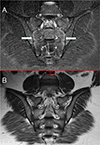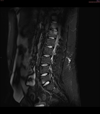Recent Updates in Juvenile Spondyloarthritis
- PMID: 34635292
- PMCID: PMC8511508
- DOI: 10.1016/j.rdc.2021.07.001
Recent Updates in Juvenile Spondyloarthritis
Abstract
Spondyloarthritis represents a group of disorders characterized by enthesitis and axial skeletal involvement. Juvenile spondyloarthritis begins before age 16. Joint involvement is usually asymmetric. Bone marrow edema on noncontrast MRI of the sacroiliac joints can facilitate diagnosis. The most significant risk factor for axial disease is HLA-B27. Most patients have active disease into adulthood. Enthesitis and sacroiliitis correlate with greater pain intensity and poor quality-of-life measures. Tumor necrosis factor inhibitors are the mainstay of biologic therapy. Although other biologics such as IL-17 blockers have shown benefit in adult spondyloarthritis, none are approved by the US Food and Drug Administration.
Keywords: Enthesitis-related arthritis; Juvenile idiopathic arthritis; Juvenile psoriatic arthritis; Pediatrics; Spondyloarthritis.
Published by Elsevier Inc.
Figures







References
-
- Rumsey DG, Laxer RM. The Challenges and Opportunities of Classifying Childhood Arthritis. Current rheumatology reports. 2020;22(1):4. - PubMed
-
- Rosenberg AM. Do we need a new classification of juvenile idiopathic arthritis? Clinical immunology (Orlando, Fla). 2020,211:108298. - PubMed
-
- Adrovic A, Sezen M, Barut K, et al. The performance of classification criteria for juvenile spondyloarthropathies. Rheumatol Int 2017;37(12):2013–2018. - PubMed
Publication types
MeSH terms
Grants and funding
LinkOut - more resources
Full Text Sources
Research Materials

